Menu

The Conservancy
Mount Vernon Place Conservancy
A mission to restore, maintain, and manage Baltimore’s Washington Monument and the surrounding squares of Mount Vernon Place.
The Mount Vernon Place Conservancy is a non-profit organization with the mission to restore, maintain, and manage Baltimore’s Washington Monument and the surrounding squares of Mount Vernon Place through a public-private partnership with the City of Baltimore. The Conservancy operates the Washington Monument, providing access and information about the site to visitors year-round. It presents free cultural programming in the park squares, including a summer concert and film series, arts and fitness classes, and large-scale festivals like the City’s annual Flower Mart and holiday Monument Lighting. As part of its partnership agreement with the City, the Conservancy provides additional maintenance for the gardens, lawns, and fountains, works with various city departments to address other park needs, and reviews permits for park use.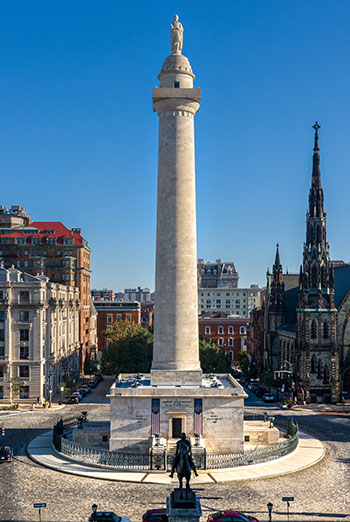
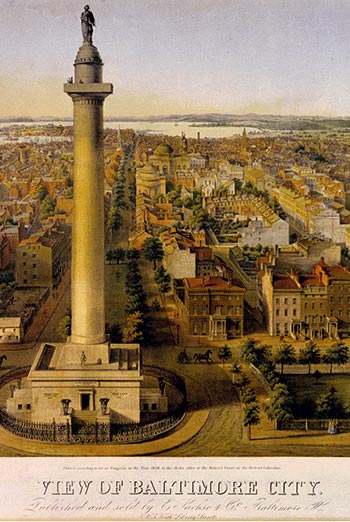
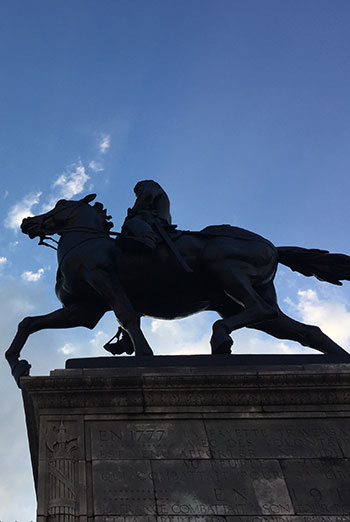
Vision for the Future
With the restoration of the Washington Monument completed, the Conservancy is now turning its focus to the four park squares of Mount Vernon Place.
One of the main goals when devising OLIN’s Master Plan (see summary) was to look at the park as a cohesive whole; not a series of streets, sidewalks, gardens, and statues, but a unified urban space that needs modern upgrades to become a more attractive, safer, accessible, and sustainable “place.”
With a team of civil engineers, arborists, stone conservation experts, and public space management specialists, OLIN’s plan looks at Mount Vernon Place holistically and addresses the needs of a modern urban park; needs that were not considered when the park was designed a century ago.
Below ground, the plan addresses outdated infrastructure, new soils to resist compaction and retain stormwater, and added irrigation systems. Above ground, new flowers, shrubs, and trees have been specifically chosen for an urban environment, allowing them to thrive into the future without compromising existing utilities and hardscapes. Historic stone elements will be preserved and restored, and accessibility and pedestrian safety tremendously increased with the addition of sidewalks and curb cuts on the perimeter of the squares.
More detailed plans have been created for the North and South Squares that adhere to the principals laid out in the approved Master Plan. An exciting look at how these squares might appear is available in our latest educational VIDEO.
The Conservancy leadership is dedicated to completing this restoration of Mount Vernon Place, reestablishing this historic space in Baltimore, and ensuring its vitality for the next century.
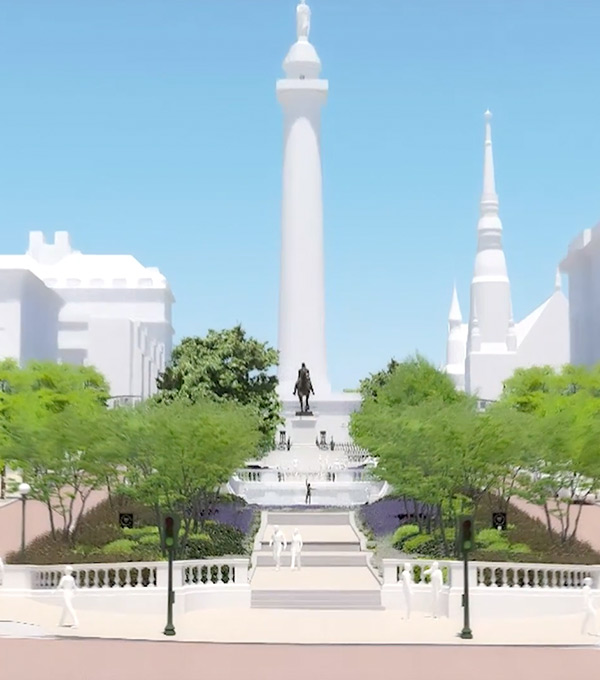
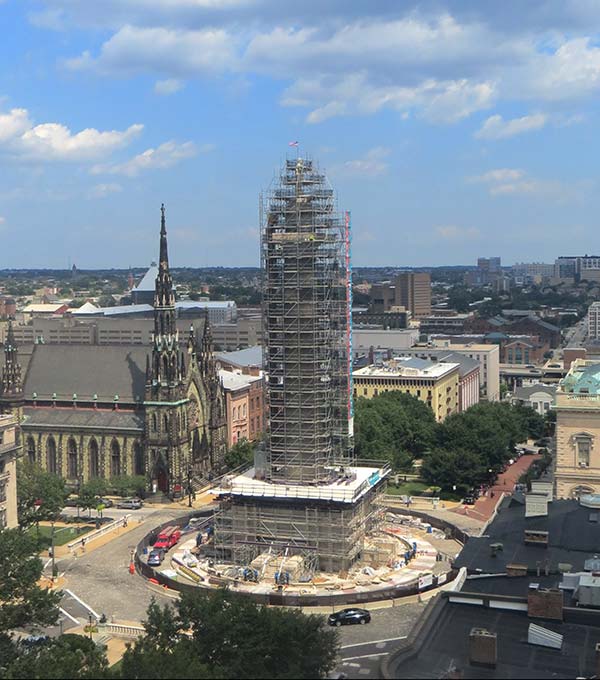
Conservancy History
In 2008 a group of Baltimore residents established the Mount Vernon Place Conservancy. One of the pressing needs for the formation of the Conservancy was the then poor conditions of the Washington Monument and the surrounding park squares. The Monument was approaching its 200th anniversary, and the park squares in their current design were almost 100 years old. At the time the Conservancy was formed it was clear that not only were plans needed to restore and revitalize these features, but significant funding would be needed to accomplish the work.
By 2010, the Washington Monument was closed to visitors by the City of Baltimore due to dangerous conditions. Shortly after, a car accident caused severe damage to sections of the iron fencing around the monument. Having secured funding to begin planning, the Conservancy hired internationally renowned landscape architects, OLIN partners in Philadelphia to develop a Master Plan for the restoration and revitalization of Mount Vernon Place. This plan was guided by extensive research into the historic design of the Monument and the existing design of the squares by Carrère & Hastings.
The City’s Commission for Historical and Architectural Preservation (CHAP), in conjunction with other City departments, approved the concepts of the Master Plan in 2011, and specifically approved the more detailed plans for the Washington Monument and the North and South Squares as presented. As further more detailed plans were developed, the Conservancy would need to return to CHAP for final approval.
After entering into its 2012 partnership agreement with the City of Baltimore, the Conservancy completed the first phase of revitalization, and restored the Washington Monument in 2014-15. The $7 million breath-taking restoration garnered an unprecedented 14 awards from the local, state, and national organizations in the design, construction, and restoration fields. Since reopening the Monument, over 100,000 guests have visited, and over 40,000 have climbed the 227 steps to take in the impressive view. These visitors come from all over the nation and world—as they have since the Monument was built. The restoration, and its many discoveries, was documented in a series of brief videos that can be viewed HERE.
Contact the Conservancy

Contact the Conservancy |
Our StaffLance Humphries, Ph.D. Emma Loftus Steven Zhu Grace Chang |
|
Board of Directors
Officers |
|||
Henry H. HopkinsPresidentRetired Chief Legal Counsel T. Rowe Price & Associates |
Faith C. MillspaughVice-PresidentMount Vernon Club |
Michael BalcomTreasurerVP, Finance Resolve Growth Partners |
Barry C. GreenbergSecretary Chair, Legal/Agreement CommitteePartner Rosenberg Martin Greenberg |
Directors |
|||
Elizabeth Bonner |
Terrell Boston-SmithCFO Board of Child Care |
Joe BrantThe Peabody Institute of the Johns Hopkins University |
Connie CaplanThe Time Group |
Adrianne Walker CarrollHaymaker Promotions |
Councilman Eric C. Costello |
Jack DannaMount Vernon-Belvedere Association |
Andrew B. Frank |
John A. GilpinCo-Chair, Maintenance & Program Committee Baltimore Community Foundation |
Jane McConnell, RN JDCo-Chair, Maintenance & Program Committee (retired) Maryland Medicine Comprehensive Insurance Program |
Therese O’Malley, Ph.D.Center for Advanced Study in the Visual Arts (retired) National Gallery of Art |
Tracy ProiettiNuovoRe |
Charles Rutheiser, Ph.DThe Annie E. Casey Foundation |
|||
Ex-Officio |
|||
Reginald MooreDirector Baltimore City Department of Recreation and Parks |
|||
Finance
Financial Info
The Conservancy operates on a fiscal year ending on the 30th of June and publishes an annual Audited Financial Statement and IRS Form 990, as well as an annual Maintenance Budget.Audited Financial Statements and IRS Form 990s:
Annual Maintenance Budgets:
For statements prior to those provided, please contact treasurer@mvpconservancy.org.
Press
Press Releases
If you are from the press, and have questions about Mount Vernon Place and/or the Mount Vernon Place Conservancy, please email info@MVPConservancy.org. | Size: 115 KB 8th Jan 2024 PRESS RELEASE: MVPC Announces Dates for 2022 Flower Mart at Mount Vernon Place (December 8, 2021) | Size: 1 MB 8th Jan 2024 PRESS RELEASE: MVPC Formed by Baltimore Mayor (November 17, 2008) | Size: 118 KB 8th Jan 2024 PRESS RELEASE: MVPC Announces Flower Mart 2021 Will Largely be a Virtual Event (February 4, 2021) | Size: 128 KB 8th Jan 2024 PRESS RELEASE: MVPC Cancels Flower Mart at Mount Vernon Place 2020 (March 17, 2020) | Size: 126 KB 8th Jan 2024 PRESS RELEASE: MVPC Announces Flower Mart at Mount Vernon Place, May 3-4, 2019 (April 24, 2019) | Size: 133 KB 8th Jan 2024 PRESS RELEASE: MVPC Opens Vendor Call for 2019 Flower Mart at Mount Vernon Place (January 7, 2019) | Size: 526 KB 8th Jan 2024 PRESS RELEASE: MVPC Announces Symphony Number One to Perform in Mount Vernon Place (August 22, 2018) | Size: 265 KB 8th Jan 2024 PRESS RELEASE: Mount Vernon Place Conservancy to manage 2019 Flower Mart (July 31, 2018) | Size: 122 KB 8th Jan 2024 PRESS RELEASE: MVPC Announces 2018 Summer in the Squares Season to Open with the Baltimore Symphony Orchestra’s OrchKids (May 16, 2018) | Size: 124 KB 8th Jan 2024 PRESS RELEASE: MVPC Announces American Friends of Lafayette to Lay Ceremonial Wreath at Statue of Lafayette on the Frenchman’s 260th Birthday (September 2, 2017) | Size: 126 KB 8th Jan 2024 PRESS RELEASE: MVPC Announces Symphony Number One to Perform in Mount Vernon Place (August 15, 2017) | Size: 353 KB 8th Jan 2024 PRESS RELEASE: MVPC Announces 13-Year Old Pennsylvania Numismatist to be Involved with Research Project Aimed at Cataloguing the Contents of the Washington Monument’s Two Time Capsules (March 24, 2017) | Size: 110 KB 8th Jan 2024 PRESS RELEASE: MVPC Washington Monument Restoration Wins 10 Awards (June 17, 2016) | Size: 266 KB 8th Jan 2024 PRESS RELEASE: MVPC Announces new Executive Director (March 21, 2016) | Size: 120 KB 8th Jan 2024 PRESS RELEASE: Treasures Unearthed From Baltimore’s Washington Monument, Maryland Historical Society (June 12, 2015) | Size: 167 KB 8th Jan 2024 PRESS RELEASE: America’s First Washington Monument Celebrates Bicentennial and Reopening on July 4th with Re-dedication Ceremony and Festival (June 2, 2015) | Size: 139 KB 8th Jan 2024 PRESS RELEASE : Mount Vernon Place Conservancy Reveals Contents of Two Time Capsules Discovered in Baltimore’s Washington Monument; Announcement of Monumental Bicentennial Celebration July 4, 2015 (June 2, 2015) | Size: 284 KB 8th Jan 2024 PRESS RELEASE: Mount Vernon Place Conservancy Hosts Viewing of Washington Monument’s Historic Cornerstone (April 12, 2015) | Size: 114 KB 8th Jan 2024 PRESS RELEASE: 200-Year-Old Cornerstone Discovered During Baltimore’s Washington Monument Restoration (February 16, 2015) | Size: 70 KB 8th Jan 2024 PRESS RELEASE: Washington Monument Time Capsule On Display at the Walters Art Museum (January 21, 2015)
Contact the Conservancy

Contact The Conservancy
- Mount Vernon Place Conservancy P.O. Box 2394 Baltimore, MD 21203
- 410-962-5070
- info@MVPConservancy.org
Our Staff
Lance Humphries, Ph.D.
Executive Director
Emma Loftus
Associate Director
Grace Chang
Site Manager
Board of Directors
Officers
Henry H. Hopkins
PresidentRetired Chief Legal Counsel
T. Rowe Price & Associates
Faith C. Millspaugh
Vice-President
Mount Vernon Club
Michael Balcom
Treasurer
VP
Finance Resolve Growth Partners
Barry C. Greenberg
Secretary Chair,
Legal/Agreement Committee
Partner
Rosenberg Martin Greenberg
Directors
Elizabeth Bonner
Terrell Boston-Smith
CFO
Board of Child Care
Joe Brant
The Peabody Institute of the Johns Hopkins University
Connie Caplan
The Time Group
Adrianne Walker Carroll
Haymaker Promotions
Councilman Eric C. Costello
Jack Danna
Mount Vernon-Belvedere Association
Andrew B. Frank
John A. Gilpin
Co-Chair, Maintenance & Program Committee
Baltimore Community Foundation
Jane McConnell, RN JD
Co-Chair, Maintenance
& Program Committee (retired)
Maryland Medicine Comprehensive Insurance Program
Therese O’Malley, Ph.D.
Center for Advanced Study
in the Visual Arts (retired)
National Gallery of Art
Tracy Proietti
NuovoRe
Charles Rutheiser, Ph.D
The Annie E. Casey
Foundation
Ex-Officio
Reginald Moore
Director
Baltimore City Department of Recreation and Parks
Finance
Financial Info
The Conservancy operates on a fiscal year ending on the 30th of June and publishes an annual Audited Financial Statement and IRS Form 990, as well as an annual Maintenance Budget.Audited Financial Statements and IRS Form 990s:
Annual Maintenance Budgets:
For statements prior to those provided, please contact treasurer@mvpconservancy.org.
Press
Press Releases
If you are from the press, and have questions about Mount Vernon Place and/or the Mount Vernon Place Conservancy, please email info@MVPConservancy.org. | Size: 115 KB 8th Jan 2024 PRESS RELEASE: MVPC Announces Dates for 2022 Flower Mart at Mount Vernon Place (December 8, 2021) | Size: 1 MB 8th Jan 2024 PRESS RELEASE: MVPC Formed by Baltimore Mayor (November 17, 2008) | Size: 118 KB 8th Jan 2024 PRESS RELEASE: MVPC Announces Flower Mart 2021 Will Largely be a Virtual Event (February 4, 2021) | Size: 128 KB 8th Jan 2024 PRESS RELEASE: MVPC Cancels Flower Mart at Mount Vernon Place 2020 (March 17, 2020) | Size: 126 KB 8th Jan 2024 PRESS RELEASE: MVPC Announces Flower Mart at Mount Vernon Place, May 3-4, 2019 (April 24, 2019) | Size: 133 KB 8th Jan 2024 PRESS RELEASE: MVPC Opens Vendor Call for 2019 Flower Mart at Mount Vernon Place (January 7, 2019) | Size: 526 KB 8th Jan 2024 PRESS RELEASE: MVPC Announces Symphony Number One to Perform in Mount Vernon Place (August 22, 2018) | Size: 265 KB 8th Jan 2024 PRESS RELEASE: Mount Vernon Place Conservancy to manage 2019 Flower Mart (July 31, 2018) | Size: 122 KB 8th Jan 2024 PRESS RELEASE: MVPC Announces 2018 Summer in the Squares Season to Open with the Baltimore Symphony Orchestra’s OrchKids (May 16, 2018) | Size: 124 KB 8th Jan 2024 PRESS RELEASE: MVPC Announces American Friends of Lafayette to Lay Ceremonial Wreath at Statue of Lafayette on the Frenchman’s 260th Birthday (September 2, 2017) | Size: 126 KB 8th Jan 2024 PRESS RELEASE: MVPC Announces Symphony Number One to Perform in Mount Vernon Place (August 15, 2017) | Size: 353 KB 8th Jan 2024 PRESS RELEASE: MVPC Announces 13-Year Old Pennsylvania Numismatist to be Involved with Research Project Aimed at Cataloguing the Contents of the Washington Monument’s Two Time Capsules (March 24, 2017) | Size: 110 KB 8th Jan 2024 PRESS RELEASE: MVPC Washington Monument Restoration Wins 10 Awards (June 17, 2016) | Size: 266 KB 8th Jan 2024 PRESS RELEASE: MVPC Announces new Executive Director (March 21, 2016) | Size: 120 KB 8th Jan 2024 PRESS RELEASE: Treasures Unearthed From Baltimore’s Washington Monument, Maryland Historical Society (June 12, 2015) | Size: 167 KB 8th Jan 2024 PRESS RELEASE: America’s First Washington Monument Celebrates Bicentennial and Reopening on July 4th with Re-dedication Ceremony and Festival (June 2, 2015) | Size: 139 KB 8th Jan 2024 PRESS RELEASE : Mount Vernon Place Conservancy Reveals Contents of Two Time Capsules Discovered in Baltimore’s Washington Monument; Announcement of Monumental Bicentennial Celebration July 4, 2015 (June 2, 2015) | Size: 284 KB 8th Jan 2024 PRESS RELEASE: Mount Vernon Place Conservancy Hosts Viewing of Washington Monument’s Historic Cornerstone (April 12, 2015) | Size: 114 KB 8th Jan 2024 PRESS RELEASE: 200-Year-Old Cornerstone Discovered During Baltimore’s Washington Monument Restoration (February 16, 2015) | Size: 70 KB 8th Jan 2024 PRESS RELEASE: Washington Monument Time Capsule On Display at the Walters Art Museum (January 21, 2015)
| Size: 115 KB 8th Jan 2024 PRESS RELEASE: MVPC Announces Dates for 2022 Flower Mart at Mount Vernon Place (December 8, 2021) | Size: 1 MB 8th Jan 2024 PRESS RELEASE: MVPC Formed by Baltimore Mayor (November 17, 2008) | Size: 118 KB 8th Jan 2024 PRESS RELEASE: MVPC Announces Flower Mart 2021 Will Largely be a Virtual Event (February 4, 2021) | Size: 128 KB 8th Jan 2024 PRESS RELEASE: MVPC Cancels Flower Mart at Mount Vernon Place 2020 (March 17, 2020) | Size: 126 KB 8th Jan 2024 PRESS RELEASE: MVPC Announces Flower Mart at Mount Vernon Place, May 3-4, 2019 (April 24, 2019) | Size: 133 KB 8th Jan 2024 PRESS RELEASE: MVPC Opens Vendor Call for 2019 Flower Mart at Mount Vernon Place (January 7, 2019) | Size: 526 KB 8th Jan 2024 PRESS RELEASE: MVPC Announces Symphony Number One to Perform in Mount Vernon Place (August 22, 2018) | Size: 265 KB 8th Jan 2024 PRESS RELEASE: Mount Vernon Place Conservancy to manage 2019 Flower Mart (July 31, 2018) | Size: 122 KB 8th Jan 2024 PRESS RELEASE: MVPC Announces 2018 Summer in the Squares Season to Open with the Baltimore Symphony Orchestra’s OrchKids (May 16, 2018) | Size: 124 KB 8th Jan 2024 PRESS RELEASE: MVPC Announces American Friends of Lafayette to Lay Ceremonial Wreath at Statue of Lafayette on the Frenchman’s 260th Birthday (September 2, 2017) | Size: 126 KB 8th Jan 2024 PRESS RELEASE: MVPC Announces Symphony Number One to Perform in Mount Vernon Place (August 15, 2017) | Size: 353 KB 8th Jan 2024 PRESS RELEASE: MVPC Announces 13-Year Old Pennsylvania Numismatist to be Involved with Research Project Aimed at Cataloguing the Contents of the Washington Monument’s Two Time Capsules (March 24, 2017) | Size: 110 KB 8th Jan 2024 PRESS RELEASE: MVPC Washington Monument Restoration Wins 10 Awards (June 17, 2016) | Size: 266 KB 8th Jan 2024 PRESS RELEASE: MVPC Announces new Executive Director (March 21, 2016) | Size: 120 KB 8th Jan 2024 PRESS RELEASE: Treasures Unearthed From Baltimore’s Washington Monument, Maryland Historical Society (June 12, 2015) | Size: 167 KB 8th Jan 2024 PRESS RELEASE: America’s First Washington Monument Celebrates Bicentennial and Reopening on July 4th with Re-dedication Ceremony and Festival (June 2, 2015) | Size: 139 KB 8th Jan 2024 PRESS RELEASE : Mount Vernon Place Conservancy Reveals Contents of Two Time Capsules Discovered in Baltimore’s Washington Monument; Announcement of Monumental Bicentennial Celebration July 4, 2015 (June 2, 2015) | Size: 284 KB 8th Jan 2024 PRESS RELEASE: Mount Vernon Place Conservancy Hosts Viewing of Washington Monument’s Historic Cornerstone (April 12, 2015) | Size: 114 KB 8th Jan 2024 PRESS RELEASE: 200-Year-Old Cornerstone Discovered During Baltimore’s Washington Monument Restoration (February 16, 2015) | Size: 70 KB 8th Jan 2024 PRESS RELEASE: Washington Monument Time Capsule On Display at the Walters Art Museum (January 21, 2015)
Contact the Conservancy

Contact the Conservancy |
Our StaffLance Humphries, Ph.D. Emma Loftus Steven Zhu Grace Chang |
|
Board of Directors
Officers |
|||
Henry H. HopkinsPresidentRetired Chief Legal Counsel T. Rowe Price & Associates |
Faith C. MillspaughVice-PresidentMount Vernon Club |
Michael BalcomTreasurerVP, Finance Resolve Growth Partners |
Barry C. GreenbergSecretary Chair, Legal/Agreement CommitteePartner Rosenberg Martin Greenberg |
Directors |
|||
Elizabeth Bonner |
Terrell Boston-SmithCFO Board of Child Care |
Joe BrantThe Peabody Institute of the Johns Hopkins University |
Connie CaplanThe Time Group |
Adrianne Walker CarrollHaymaker Promotions |
Councilman Eric C. Costello |
Jack DannaMount Vernon-Belvedere Association |
Andrew B. Frank |
John A. GilpinCo-Chair, Maintenance & Program Committee Baltimore Community Foundation |
Jane McConnell, RN JDCo-Chair, Maintenance & Program Committee (retired) Maryland Medicine Comprehensive Insurance Program |
Therese O’Malley, Ph.D.Center for Advanced Study in the Visual Arts (retired) National Gallery of Art |
Tracy ProiettiNuovoRe |
Charles Rutheiser, Ph.DThe Annie E. Casey Foundation |
|||
Ex-Officio |
|||
Reginald MooreDirector Baltimore City Department of Recreation and Parks |
|||
Finance
Financial Info
The Conservancy operates on a fiscal year ending on the 30th of June and publishes an annual Audited Financial Statement and IRS Form 990, as well as an annual Maintenance Budget.Audited Financial Statements and IRS Form 990s:
Annual Maintenance Budgets:
For statements prior to those provided, please contact treasurer@mvpconservancy.org.
Press
Press Releases
If you are from the press, and have questions about Mount Vernon Place and/or the Mount Vernon Place Conservancy, please email info@MVPConservancy.org.
View Press Releases →
Contact the Conservancy

Contact The Conservancy
- Mount Vernon Place Conservancy P.O. Box 2394 Baltimore, MD 21203
- 410-962-5070
- info@MVPConservancy.org
Our Staff
Lance Humphries, Ph.D.
Executive Director
Emma Loftus
Associate Director
Grace Chang
Site Manager
Board of Directors
Officers
Henry H. Hopkins
PresidentRetired Chief Legal Counsel
T. Rowe Price & Associates
Faith C. Millspaugh
Vice-President
Mount Vernon Club
Michael Balcom
Treasurer
VP
Finance Resolve Growth Partners
Barry C. Greenberg
Secretary Chair,
Legal/Agreement Committee
Partner
Rosenberg Martin Greenberg
Directors
Elizabeth Bonner
Terrell Boston-Smith
CFO
Board of Child Care
Joe Brant
The Peabody Institute of the Johns Hopkins University
Connie Caplan
The Time Group
Adrianne Walker Carroll
Haymaker Promotions
Councilman Eric C. Costello
Jack Danna
Mount Vernon-Belvedere Association
Andrew B. Frank
John A. Gilpin
Co-Chair, Maintenance & Program Committee
Baltimore Community Foundation
Jane McConnell, RN JD
Co-Chair, Maintenance
& Program Committee (retired)
Maryland Medicine Comprehensive Insurance Program
Therese O’Malley, Ph.D.
Center for Advanced Study
in the Visual Arts (retired)
National Gallery of Art
Tracy Proietti
NuovoRe
Charles Rutheiser, Ph.D
The Annie E. Casey
Foundation
Ex-Officio
Reginald Moore
Director
Baltimore City Department of Recreation and Parks
Finance
Financial Info
The Conservancy operates on a fiscal year ending on the 30th of June and publishes an annual Audited Financial Statement and IRS Form 990, as well as an annual Maintenance Budget.Audited Financial Statements and IRS Form 990s:
Annual Maintenance Budgets:
For statements prior to those provided, please contact treasurer@mvpconservancy.org.
Press
Press Releases
If you are from the press, and have questions about Mount Vernon Place and/or the Mount Vernon Place Conservancy, please email info@MVPConservancy.org.
View Press Releases →
The Mount Vernon Place Conservancy, Inc. continues to work to build a more diverse, inclusive team that reflects the Baltimore community where we live, work and play. This commitment extends to both our board and staff, as well as to the many performers and vendors who contribute to our programming.